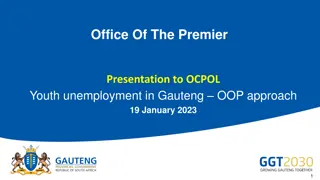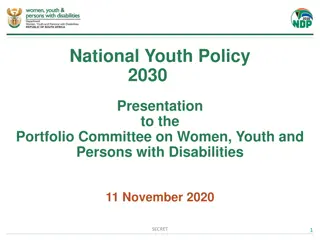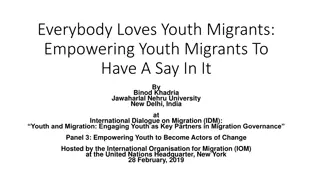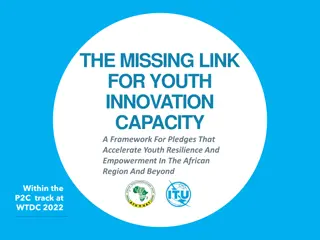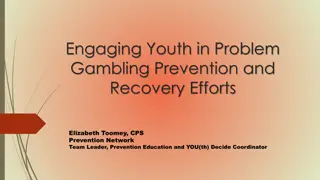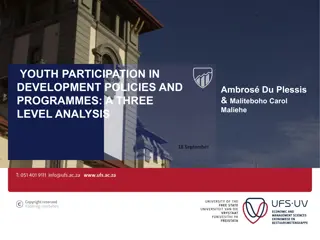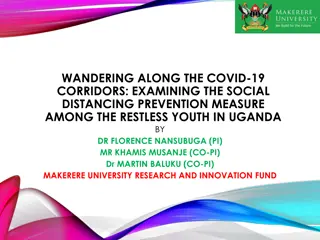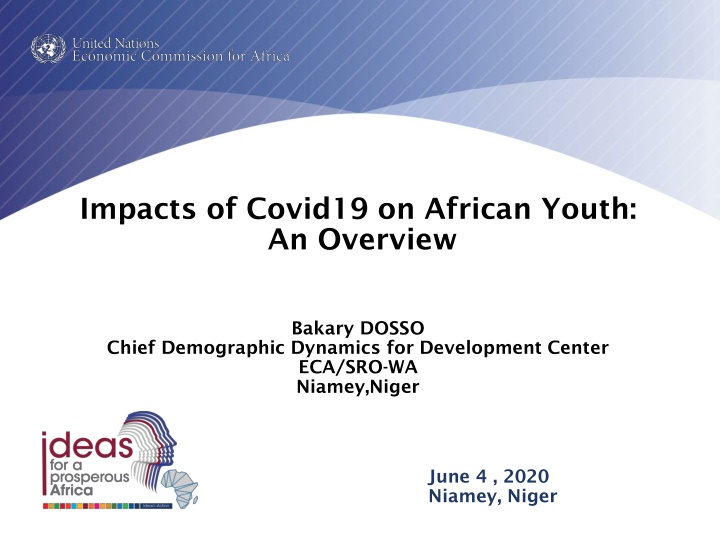
Impact of COVID-19 on African Youth: Overview of Challenges and Consequences
The COVID-19 pandemic has significantly affected African youth, particularly in terms of economic opportunities, education, and overall well-being. The disruption caused by the pandemic has led to massive unemployment, revenue losses, and increased poverty levels, with a potential for millions to fall into extreme poverty. Additionally, school closures and barriers to digital learning have exacerbated existing inequalities and challenges in the education sector. This overview highlights the various impacts of COVID-19 on African youth across different sectors and regions.
Download Presentation

Please find below an Image/Link to download the presentation.
The content on the website is provided AS IS for your information and personal use only. It may not be sold, licensed, or shared on other websites without obtaining consent from the author. If you encounter any issues during the download, it is possible that the publisher has removed the file from their server.
You are allowed to download the files provided on this website for personal or commercial use, subject to the condition that they are used lawfully. All files are the property of their respective owners.
The content on the website is provided AS IS for your information and personal use only. It may not be sold, licensed, or shared on other websites without obtaining consent from the author.
E N D
Presentation Transcript
Impacts of Covid19 on African Youth: An Overview Bakary DOSSO Chief Demographic Dynamics for Development Center ECA/SRO-WA Niamey,Niger June 4 , 2020 Niamey, Niger
COVID-19: a health pandemic with major socio-economic impacts The COVID-19 Pandemic is expected to reduce Africa s 2020 GDP growth to 1.8% growth or in the worst case scenario, 2.6% contraction, further limiting governments abilities to effectively respond. The disruption of the supply chains and the lockdown are producing huge unemployment and revenue losses and worsening poverty and inequality. This has the potential to push 27 million people into extreme poverty. Young people (15-24), mostly depending on a rather widespread informal sector and SMEs, will be the most affected by the impacts of the pandemic. Source: ECA, 2020
Case study: Impact of COVID-19 on the private sector in Cameroon Enterprises survey in Cameroon reveals that Informal production Units and SME are much more impacted by definitive and temporary closure of activities. Young people would therefore be more concerned COVID 19 impacts by category of enterprises 14.70% 16.20% Big entreprises 63.20% 4.40% 1.50% 3.50% 15.20% SME 63.90% 15.90% 1.50% 7.10% 14.30% Informal Production Units 65.60% 11.30% 1.70% small slowdom Average slowdow Important slowdown of activities Temporary closure Definitive closure 0.00% 10.00% 20.00% 30.00% 40.00% 50.00% 60.00% 70.00% Source: ECA/SRO-CA
Case study: Impact on education in Southern Africa Countries have implemented nation-wide school closures, with exception of Lesotho which has implemented localized closures 48,365,522 learners from pre-primary to the tertiary levels have been affected: 48.9 per cent of females and 51.1 per cent of males Countries have implemented measures such as digital distance learning via online platforms, TV and radio programs to help mitigate the adverse impacts But persisting barriers: intermittent disruption of internet connectivity; limited access and high cost; intermittent cuts in power supply Internet penetration very low in countries like Malawi at 10% and highest in Mauritius, 56.5% and South Africa, 53.2% Disrupted education may exacerbate teenage pregnancy and school dropout, undernutrition, deepen poverty and inequality gap especially for the under- privileged population of learners WFP school feeding disrupted in DR Congo, Congo, Zambia, Malawi, Mozambique, Lesotho, Madagascar 2.2 million primary and pre-primary children reached in 2018
DEMOGRAPHY OF AFRICAN YOUTH IN 2020 0-14 Years M 50.7% 50.5% 50.5% 50.9% 51.2% 15-24 Years M 50.4% 50.1% 50.3% 50.7% 51.1% 15-29 Years M 50.4% 50.0% 50.3% 50.6% 50.9% 15-34 Years M 50.3% 49.8% 50.3% 50.6% 50.7% F F F F Africa Eastern Africa Southern Africa Western Africa Northen Africa 49.3% 49.5% 49.5% 49.1% 48.8% 49.6% 49.9% 49.7% 49.3% 48.9% 49.6% 50.0% 49.7% 49.4% 49.1% 49.7% 50.2% 49.7% 49.4% 49.3% Distribution of total Population of Africa by region for youth in 2020 Total Population Africa in 2020: 1,340 millions 45% 43% 42% 40% 35% 35% 34% 34% 33% 33% 32% 30% Population 15-24 years: 254 millions Northern Africa Central Africa Western Africa Eastern Africa Southern Africa Africa 0-14 15-24 15-29 15-34 Source: ECA based on UNDESA
DEMOGRAPHY OF AFRICAN YOUTH IN 2020 Distribution of Youth (15-24) not in employment, education or training (NEET) in Africa in 2020 Total Dependency ratios in Africa in 2020 32.8% 80.985.091.6 26.9% 78.1 24.3% 62.5 53.6 18.9% 14.0% Eastern Africa Central Africa Western Africa Northern Africa Southern Africa Source: ECA based on UNDESA Source: ECA based on ILO (2020)
Economic Support Ratio ? represents purchasing power of each age group THE RATIO BETWEEN THE NUMBER OF THE RATIO BETWEEN THE NUMBER OF EFFECTIVE PRODUCERS AND THE NUMBER OF EFFECTIVE PRODUCERS AND THE NUMBER OF EFFECTIVE CONSUMERS EFFECTIVE CONSUMERS ? represents the distribution of consumption needs by age THE GROWTH RATE OF THE SUPPORT RATIO THE GROWTH RATE OF THE SUPPORT RATIO REPRESENTS THE FIRST DEMOGRAPHIC REPRESENTS THE FIRST DEMOGRAPHIC DIVIDEND DIVIDEND
Life Cycle Deficit (LCD) At each age, a: Fundamental Equation of NTA ??? + ??? + ?+? =? ? + ? ? +? ? a: Age ??: Labor income ??: Asset income ?+: Transfers received ? : Transfers paid ?: Consumption S: Savings Life Cycle Deficit (LCD): consumption needs to satisfy at each age LCD= ? ? ??? = ??? ? ? + ?+? ? ? Life Cycle Deficit redeployment Asset Net transfers Year based Redeployment A positive LCD(a) indicates a consumption surplus (or income deficit) requiring reallocations from other age groups with income surplus. A negative LCD(a) means a surplus of income, which can be used to finance the consumption of deficit age groups
START and END YEAR OF GENERATION OF SURPLUS Start year of Start year of surplus surplus 28 28 23 23 26 26 31 31 26 26 End year of End year of Surplus Surplus 64 64 56 56 57 57 62 62 56 56 Duration Duration of Surplus of Surplus 36 36 33 33 31 31 31 31 30 30 Central Africa Central Africa Northern Africa Northern Africa Southern Africa Southern Africa Western Africa (ECOWAS) Western Africa (ECOWAS) Eastern Africa Eastern Africa Source: CREG estimates, 2020 o The earliest surplus starts at 23 years in Northern Africa and the latest at 31 years in Western Africa o The highest duration of surplus is 36 years and is observed in Central Africa and the smallest duration is 30 years in Eastern Africa
LIFE CYCLE DEFICIT FOR YOUTH LCD LCD Global Global Youth 15 Youth 15- - 34 as % 34 as % GDP GDP 3.7% 3.7% 0.7% 0.7% - -6.3% 6.3% 7.9% 7.9% 16.9% 16.9% LCD Global LCD Global 15 15- -24 (Billions (Billions USD) USD) 47.54 47.54 17.85 17.85 143.53 143.53 80.29 80.29 206.46 206.46 LCD Global LCD Global 15 15- -29 (Billions (Billions USD) USD) 43.57 43.57 13.24 13.24 12.91 12.91 74.50 74.50 249.57 249.57 LCD LCD 24 29 LCD Global 15 LCD Global 15- - 34 (Billions 34 (Billions USD) USD) 26.16 26.16 3.32 3.32 - -133.52 133.52 59.81 59.81 243.69 243.69 LCD Global LCD Global 15 15- -24 as % 24 as % GDP GDP 6.7% 6.7% 3.8% 3.8% 6.8% 6.8% 10.6% 10.6% 14.3% 14.3% Global 15 Global 15- - 29 as % 29 as % GDP GDP 6.1% 6.1% 2.8% 2.8% 0.6% 0.6% 9.8% 9.8% 17.3% 17.3% Eastern Africa Eastern Africa Central Africa Central Africa Northern Africa Northern Africa Southern Africa Southern Africa Western Africa Western Africa Source: CREG estimates, 2020 o Life Cycle deficit for youth ranges between 0.7% (Central Africa) to 16.9% (Western Africa) of GDP for all the regions except Northern Africa o In Northern Africa, Youth generates a surplus of 6.3% of GDP and this ressource is reallocated to other age groups
POTENTIAL GAINS as percentage of GDP TO PROVIDE JOBS TO YOUTH The potential GDP gain is $78 billion/year, if Youth from 15 to the start year of surplus, who are NEET were provided jobs that allow them to just cover their deficit: 6.4% 3.4% 3.11% 2.0% 1.0% 0.6% Central Africa Eastern Africa Northern Africa Southern Africa Western Africa AFRICA Source: CREG estimates, 2020
ECONOMIC SUPPORT RATIO & 1st DD o Support Ratio of West Africa and East Africa are increasing while that of other regions have a downward trend Economic Support Ratio in Africa 60% 59% 56% 53% 55% 50% 50% o SR: West : 43% to 59% from 2020 to 2095; Central :50% to 44% on the same period 44% 45% 43% 40% 2015 2020 2025 2030 2035 2040 2045 2050 2055 2060 2065 2070 2075 2080 2085 2090 2095 2100 SR_Central SR_East SR_North SR_South SR_West o Window closed for Northern Africa at the beginning of the last decade o Window of Opportunity will be closed for the Southern Africa in 2040, between 2055- 2060 for the Central Africa and for Eastern Africa in 2080 o Window will not be closed for Western Africa before 2100 of Opportunity 1st Demographic Dividend in Africa 0.60 0.40 0.20 0.00 -0.20 -0.40 -0.60 -0.80 -1.00 DD_Central DD_East DD_North DD_South DD_West Source: CREG estimates, 2020
COST OF INACTION o The health crisis could become a structural crisis with a loss of productivity and could harm youth economic potentials o The COVID19 could cause a loss of 1% to 2% of SR. In normal situations, 5 years are required to get at 1% of Support ratio (SR). o Need to provide employment opportunities to youth not only to benefit from their potentials but also to avoid a crisis similar to the Arab spring in other regions: probably around 2040 for Southern Africa, 2060 for Middle Africa, 2080 for Eastern Africa.
Observations, Mitigations Some Mitigations Observations Tracking socioeconomic effects of covid-19 is not disaggregated by sex, neither does it take youth into consideration; Support financing workers, special lines of credit etc.) firms partial guaranteed (tax measures, unemployed loans and Support workers and vulnerable populations through targeted policies and wide social protection measures (cash transfers, unemployment benefits and paid sick leave protection, food access etc.). food aid, Handling of the pandemic is gender blind; Minimize disruptions to supply chains; Encourage the use of technology for financial transactions Support the vulnerable through social protection measures including food aid Draw lessons from Ebola when women suffered setbacks
Opportunities and Conclusions Africa s young people are pivotal to its growth and sustainable development. The potential GDP gain is $78 billion/year, if Youth from 15 to the start year of surplus, who are NEET are provided jobs that allow them to just cover their deficit: To fully exploit the potential demographic dividend, Governments need not only to maintain their current level of services, but also to increase per capita investments in health, education, infrastructure and in the future of work Unfortunately, COVID-19 threatens to undermine gains in efforts made to integrate youth into Africa s productive labour force with implications for the SDGs Agenda 2030 and Agenda 2063 The burden of mortality falls on the older population but the socioeconomic impacts are felt by the younger population Women and other vulnerable groups (people living with disability, HIV, etc.) need to be prioritized for interventions The voices, and contribution of African Youth are critical in shaping the narrative for building back better Africa s economic and social fabrics Fostering of innovation, entrepreneurship and technology to transform challenges of COVID-19 into opportunities is therefore key for dialogue








